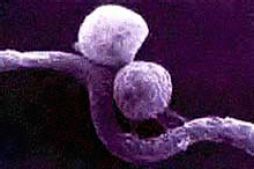The species, B. burgdorferi, has never been found naturally outside of a host.
This indicates that it requires a host body in order to reproduce itself.
 |
| Fig.20. Stages in Binary Fission |
Upon entering the host, B. burgdorferi reproduces asexually mainly
through binary fission.
However, it also uses other methods of
reproduction, one of which involves the formation of a cyst.
 |
| Fig.21. The Formation of a B. burgdorferi's Cyst |
Another mechanism of reproduction that this bacterium utilizes is the formation of buds, which then can eventually turn into cysts.
The bursting of the B. burgdorferi cell that contain these underdeveloped forms is how they are released.
B. burgdorferi
has a unique ability to reproduce wherever and whenever as needed, no matter
the surroundings, while also simultaneously protecting itself from its hosts’
immune system.
Its ability to reproduce is one of the many
contributions to its success in invading host organisms.
Not much info here. Waste of time.
ReplyDeleteI object. The cyst formation picture is one I have never seen before. It quite looks like a spore, more than a cyst!
Delete